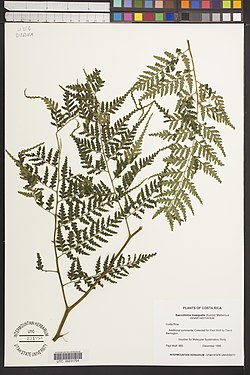| Saccoloma | |
|---|---|
 | |
| Saccoloma inaequale herbarium specimen | |
| Scientific classification | |
| Kingdom: | Plantae |
| Clade: | Tracheophytes |
| Division: | Polypodiophyta |
| Class: | Polypodiopsida |
| Order: | Polypodiales |
| Family: | Saccolomataceae |
| Genus: | Saccoloma Kaulf. |
| Type species | |
| Saccoloma elegans | |
| Species | |
| Synonyms [1] | |
| |
Saccoloma is a fern genus in family Saccolomataceae. [2] [3] It is the only genus in the family in the Pteridophyte Phylogeny Group classification of 2016 (PPG I), but further investigation is needed. [2] It is pantropical and its species are found in wet, shaded forest areas. [4] Saccoloma species are characterized by an omega-shaped (Ω) vascular bundle in the cross-sections of their petioles. [5] [6] The common name soralpouch fern is used for Saccoloma. [7]